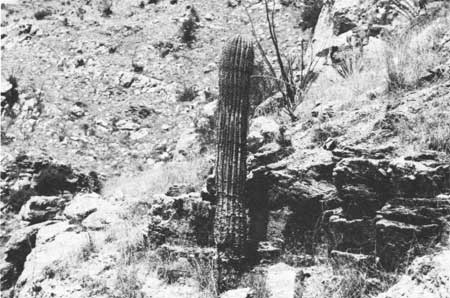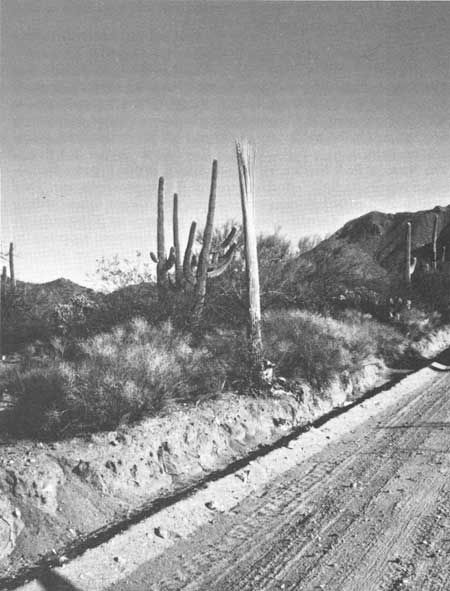|
SAGUARO
Ecology of the Saguaro: II NPS Scientific Monograph No. 8 |

|
CHAPTER 6:
OVERVIEW AND OUTLOOK (continued)
Fire control
Fire is a natural cause of mortality of young saguaros near the upper elevational limits of their distribution. The relative importance of this factor under natural conditions is not known. However, our observations on natural fire-caused saguaro deaths in the Coronado and Tonto national forests in Arizona indicate that fire is a density-controlling factor in ungrazed habitats where grasses and other low-growing plant species provide a sufficiently continuous cover of combustible fuel to permit the spread of natural fire (Fig. 51). In such habitats, saguaros closely associated with combustible plant material—in grass, "amole" (Agave schotti), low shrubs, or lifter beneath trees—are highly vulnerable to fire-kill. However, saguaros situated in relatively barren rock outcrops survive fire with little or no damage.
There is no known instance of fire-caused saguaro deaths within Saguaro National Monument. This is a result not only of a strict policy of controlling all fires but even more directly a consequence of cattle grazing. Grasses that naturally would form a more-or-less-continuous ground cover on the rocky footslopes have been closely cropped, and their density has been drastically reduced by long-continued cattle grazing (Fig. 49A). Fires can neither start nor spread in these denuded, grossly altered environments. In that limited and local sense it might be said that cattle grazing may have benefited saguaro survival in the monument.

|
| Fig. 51A. Fire-killed saguaros and foothill paloverde trees (Cercidium microphyllum) in Tonto National Forest approximately 56 km (35 miles) northeast of Phoenix, Arizona. Seventeen of the 19 saguaros in the photograph were killed by an intense ground fire in the dry autumn of 1973, following the unusually heavy production of annual forbs and grasses earlier in that year. Fires start and spread readily through the ground level accumulation of dead, dry forbs and grasses produced in desert scrub by unusually heavy winter, spring, and/or summer rains. Photographed 18 June 1974. |
Predator control
Predator control within and adjacent to both sections of Saguaro National Monument continued into the last decade cannot, with certainty, be related to the past and present condition of saguaro stands within the boundary. The whole question of the effect of predator control on fluctuations in rodent populations seems inseparably related to a host of other factors ultimately of equal or greater importance in the dynamics of desert rodent populations. These include food and water supply, habitat modifications produced by livestock grazing, climatic cycles, and the resulting complex interactions including predation.
Ultimately, it seems that the most that can be said with regard to predator control is that to some degree it may have allowed populations of some prey species to increase until some other environmental factor became limiting on their numbers. There are no data that show that an increase in rodent predators on young saguaros actually resulted from predator control, that rodent populations were maintained at unnaturally high levels, or that the establishment of young saguaros was unnaturally limited by high populations of rodents resulting from the control of predators.

|
| Fig. 51B. A fire-scarred saguaro, survivor of a July 1968 lightning-caused fire on the ungrazed slopes of the Santa Catalina Mountains, Coronado National Forest northeast of Tucson, Arizona. In such habitats, saguaros closely associated with an abundance of dry fuel—dense grass, shrubs, and other plants, or accumulated litter beneath trees—are highly vulnerable to fire-kill. However, saguaros often survive in relatively barren outcrops where there is little or no fuel to support the ground fire. Photographed 4 August 1969. |
Except for the small effect of a limited amount of hunting outside the boundaries, the level of predator populations today appears essentially as before within the two units of the monument. Whatever the previous consequences of predator control on these saguaro populations, the present condition is that of an essentially natural relationship.
Other decimating factors
Since the establishment of Saguaro National Monument, some lack of saguaro establishment and survival must be attributed to the actions of monument users, and to certain management activities of the National Park Service itself. This has resulted not only from the direct destruction of many young saguaros but also from the inadvertent creation of environments in which the saguaro cannot become established or survive. These factors, briefly discussed here, are further detailed in Appendix I, Management Recommendations.
The construction and maintenance of roads, parking facilities, and related drainage control devices through the heart of the most spectacular saguaro stands in both sections of the monument have involved the direct removal of young (and some old) plants (Figs. 52 and 53). These developments have also eliminated a substantial area of formerly prime saguaro habitat.
Both causes and rates of saguaro mortality increase with proximity to roadways and parking areas (Figs. 52 and 55B). Easy access and intensive use are accompanied by higher rates of vandalism on saguaros of all sizes. Saguaros attract and are highly vulnerable objects of vandalism (Fig. 53B); small plants are easily removed completely. Younger plants are especially subject to injury, destruction, and removal, and deterioration of saguaro habitat occurs with intensive use of areas adjacent to parking sites.

|
| Fig. 52A. Dead, roadside saguaro, Tucson Mountains, Saguaro National Monument (west). High mortality of saguaros immediately adjacent to graded roads is primarily attributable to conventional road maintenance practices (see Fig. 52B). Photographed 29 November 1973. |

|
| Fig. 52B. Closeup showing saguaro roots severed by roadgrader (saguaro shown in Fig. 52A). The primary root system of the saguaro lies within 2 ft (0.6 m) of the soil surface. This plant has lost nearly half of its root system. Such injury results not only in loss of plant vigor but greatly increases vulnerability to freezing and windthrow. Photographed 29 November 1973. |

|
| Fig. 53A. Concentrated visitor user—as in this picnic area—hastens the death of living saguaros and precludes the establishment of new individuals. Vandalism and soil compaction reduces the vigor of old plants. Establishment of young saguaros cannot occur on barren, intensively used sites. Continued intensive use of these sites will lead to the eventual elimination of their two principal attractions—saguaros and shade. Photographed 1 December 1969. |

|
| Fig. 53B. Vandalized young saguaro adjacent to picnic area shown in Fig. 53A. Vandalism on standing saguaros, large and small, and the removal of easily uprooted smalls saguaros is most severe in the immediate vicinity of intensively used recreational facilities and roads. Photographed 22 May 1969. |
Saguaros immediately adjacent to roadways are left with only partially functional root systems, the shallow roots either severed or covered with pavement or compacted soil (Fig. 52). The vigor of such plants is impaired by reduced water-uptake capability, and vulnerability to windthrow is greatly increased.
Freeze-caused mortality is increased by close proximity to unpaved roadways (Fig. 55A). During cold winter nights, the greatest extremes of low temperatures are associated with the high rates of nocturnal re-radiation from these barren surfaces. The lack of protective vegetation further increases the vulnerability of roadside saguaros to freezing (Lowe and Hinds 1971; Steenbergh and Lowe 1976; Fig. 55B).
Picnic areas, without exception, have been developed in prime saguaro habitats; generally, most of the decimating factors associated with roadways apply to the establishment and survival of saguaros at and near these locations (Fig. 53). Vandalism, destruction of vegetation, and soil compaction have virtually precluded the establishment and survival of young saguaros, have caused the death of many of the older saguaros, and with continued use, will in time eliminate the remaining large saguaros at these locations. Furthermore, the areas surrounding these sites are subject to intensive use and associated vandalism and removal of young saguaros (Fig. 53B).
The "bacterial necrosis disease" as an historical factor
The long-continued commitment to the "bacterial necrosis disease" hypothesis and the medical approach to the problem of saguaro population decline, reviewed in Chapter I, have had a number of unfortunate consequences for the public, the National Park Service, and the scientific community.
The National Park Service, in the acceptance of that hypothesis, contributed heavily to futile efforts to control the supposed disease. They also supported pathology-oriented research that sought unsuccessfully to explain the lack of seedling establishment and survival. Substantial effort and money were expended to develop management programs to correct a condition of undetermined cause. Much important information was gained from these efforts, but the primary question remained unanswered and appropriate management programs could not be developed or implemented without the answers to the question of cause.
With the acceptance of the ecologically untenable "disease" hypothesis in 1941, the primary cause of the observed saguaro deaths—freezing—passed completely unrecognized, as did the controlling relationship between that factor and the establishment and survival of young saguaros. As a consequence, the critical questions on the role of freezing weather in these populations remained unasked for nearly two more decades.
For the public and the National Park Service, a most unfortunate consequence of the emotionally appealing hypothesis was the widely accepted and now firmly entrenched belief in a devastating, but hopefully curable, "disease" that supposedly threatened the saguaro with early extinction.
| <<< Previous | <<< Contents >>> | Next >>> |
chap6b.htm
Last Updated: 21-Oct-2005